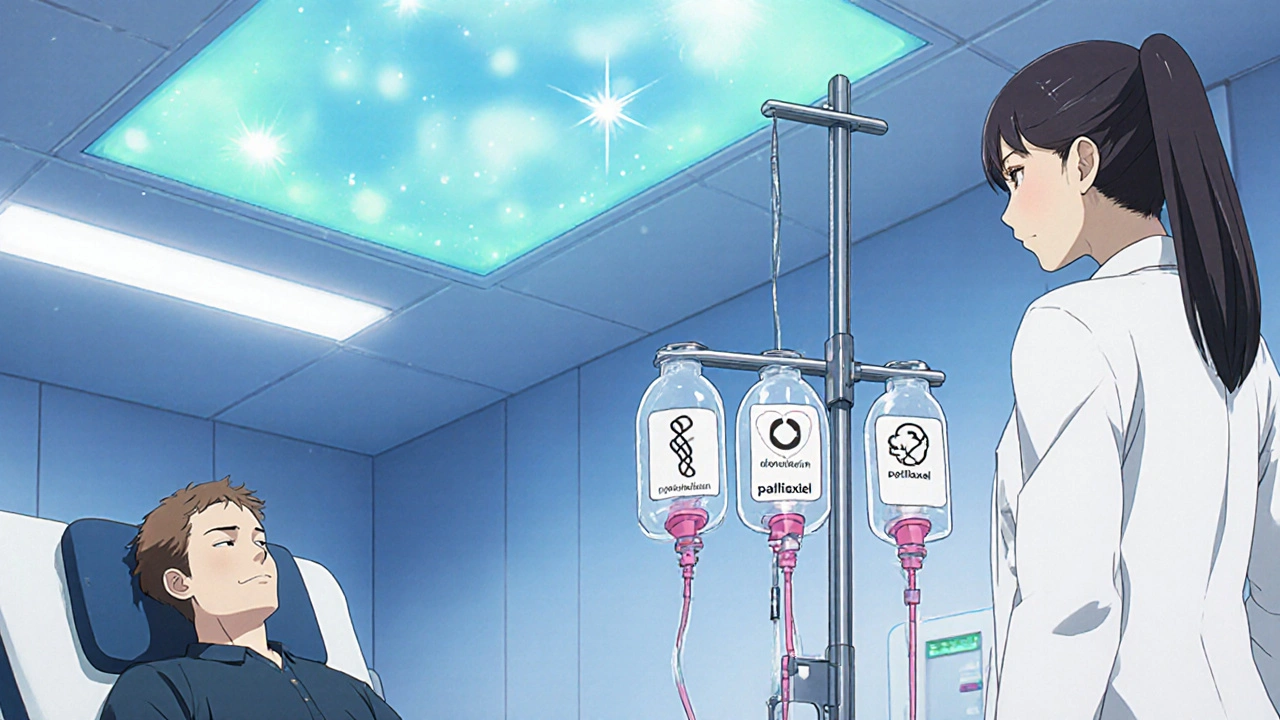Chemotherapy Regimen Advisor
Treatment Information
Side Effect Management Tips
Key Takeaways
- Chemotherapy targets fast‑growing cancer cells but also affects healthy tissue, so side‑effects are common.
- Typical regimens combine drugs like doxorubicin and paclitaxel to attack different growth pathways.
- Before your first session, arrange transportation, discuss fertility preservation, and stock up on nausea‑relief foods.
- Managing side‑effects early-such as neutropenia, fatigue, and peripheral neuropathy-helps keep treatment on schedule.
- Close communication with your oncology team, including your oncologist, is essential for adjustments.
Understanding Chemotherapy for Breast Disease
When facing Chemotherapy is a systemic treatment that uses anti‑cancer drugs to destroy rapidly dividing cells, understanding its role in breast cancer is crucial before you start. Unlike surgery or radiation, which focus on a specific area, chemo circulates through the bloodstream, seeking out cancer cells wherever they may be.
Historically, chemo became a standard part of breast‑cancer care after large clinical trials in the 1970s showed it could cut recurrence rates by up to 30 %. Modern protocols are more personalized: they consider tumor size, hormone‑receptor status, HER2 expression, and genetic markers such as BRCA1/2.
How Treatment Plans Are Designed
Your treatment journey begins with staging and molecular profiling. The oncologist, often supported by a multidisciplinary team (including a surgeon, radiation oncologist, and a genetic counselor), will map out a schedule that typically spans 3‑8 months.
Key decision points include:
- Adjuvant vs. neoadjuvant: If the tumor is operable, chemo may be given after surgery (adjuvant) to eliminate unseen cells. If the tumor is large, chemo might come first (neoadjuvant) to shrink it and allow breast‑conserving surgery.
- Drug selection: Based on hormone‑receptor and HER2 results. Hormone‑positive tumors often pair chemo with endocrine therapy later.
- Frequency: Most regimens are given every 2-3 weeks (called cycles). Some newer approaches use weekly low‑dose infusions.
Open discussion about fertility, work commitments, and support systems should happen early, because changes may be needed mid‑course.

Common Chemotherapy Regimens and What They Mean
Several drug combinations have become standards of care. Below is a snapshot of the most frequently used regimens, their typical cycle length, and key side‑effects.
| Regimen | Drugs Included | Cycle Length | Major Side‑effects |
|---|---|---|---|
| AC | doxorubicin + cyclophosphamide | Every 3 weeks, ×4 | Cardiotoxicity (rare), nausea, neutropenia |
| TC | docetaxel + cyclophosphamide | Every 3 weeks, ×4 | Hair loss, neuropathy, fluid retention |
| TAC | docetaxel, doxorubicin, cyclophosphamide | Every 3 weeks, ×6 | Increased fatigue, higher risk of neutropenia |
| CMF | cyclophosphamide, methotrexate, 5‑fluorouracil | Every 3 weeks, ×6 | Mild nausea, hand‑foot syndrome |
Newer targeted agents (like trastuzumab for HER2‑positive disease) are often added to these backbones, but the core chemo drugs remain the ones listed above.
Managing Side‑effects Effectively
Side‑effects are the most common reason patients miss cycles. Proactive management keeps you on track and improves quality of life.
- Neutropenia: Low white‑blood‑cell counts raise infection risk. Your team may prescribe growth‑factor injections (e.g., filgrastim) after each cycle.
- Nausea & vomiting: Modern anti‑emetics (ondansetron, aprepitant) are highly effective. Keep a stash of ginger tea or plain crackers handy.
- Fatigue: Short, frequent walks and light strength training help maintain energy. Prioritize sleep hygiene-dark room, no screens before bed.
- Peripheral neuropathy: Common with taxanes like paclitaxel. Use supportive footwear, avoid tight shoes, and report tingling early.
- Hair loss: Scalp cooling caps can reduce loss for some patients. Many find wigs or scarves boost confidence.
Always inform your oncology nurse of new symptoms; adjustments (dose reduction, drug switch) are possible without compromising cure rates.
Preparing for Your First Chemotherapy Session
Preparation reduces anxiety and prevents last‑minute hiccups.
- Transportation: Arrange a driver, friend, or ride‑share. You won’t be able to drive for 24‑48 hours after infusion.
- Hydration: Drink plenty of water the day before, unless your doctor advises otherwise.
- Medication review: Bring a list of all meds, supplements, and over‑the‑counter drugs. Some herbs (like St. John’s wort) can interfere with chemo metabolism.
- Fasting guidelines: Some regimens require an empty stomach; follow instructions from the infusion nurse.
- Comfort items: Pack a pillow, a light blanket, headphones or a playlist, and a book or tablet. Infusion rooms can be chilly.
- Insurance & paperwork: Verify coverage for each drug and any supportive meds (anti‑emetics, growth factors).
After the infusion, you’ll spend about an hour in a recovery area while nurses monitor vitals. Most patients feel “zoned out” for a short period-the drugs can cause mild dizziness.

When to Call Your Oncology Team
Knowing the red‑flag symptoms that need immediate attention can prevent emergencies.
- Fever over 38 °C (100.4 °F) with chills - possible infection.
- Severe shortness of breath or chest pain.
- Persistent vomiting lasting more than 24 hours.
- Uncontrolled bleeding or bruising.
- Sudden, severe neuropathy that affects grip or walking.
For non‑urgent concerns (mild nausea, mild fatigue), most clinics have a nurse line you can call during business hours.
Frequently Asked Questions
How many chemotherapy cycles will I need?
The number varies by regimen. Common plans range from four to eight cycles, each spaced three weeks apart. Your oncologist will tailor the total based on tumor response and your tolerance.
Will chemotherapy cure my breast cancer?
Chemo aims to reduce recurrence risk and, in many cases, eradicate microscopic disease left after surgery. Cure rates depend on stage, biology, and how completely the treatment is delivered.
Can I continue working during chemo?
Many patients maintain part‑time or even full‑time work, especially during the first few cycles when side‑effects are milder. Discuss your schedule with your doctor; they may suggest flexible hours or remote tasks.
What fertility options exist before starting chemo?
Options include egg or embryo freezing, ovarian tissue preservation, and temporary use of GnRH agonists to protect ovarian function. Speak with a fertility specialist early-some procedures need to be done weeks before chemotherapy.
How do I manage emotional stress during treatment?
Counseling, support groups, mindfulness apps, and talking openly with family can help. Many hospitals offer psycho‑oncology services at no extra cost.
Putting It All Together
Starting chemotherapy for breast disease is a big step, but knowledge turns uncertainty into confidence. By understanding the drugs-like doxorubicin and paclitaxel-knowing the schedule, preparing ahead, and having a solid plan for side‑effects, you give yourself the best chance to complete treatment on time.
Remember, every patient’s journey is unique. Use this guide as a foundation, ask questions, and lean on your care team. The goal is not just to survive, but to thrive after treatment.



Kate McKay
October 20, 2025 AT 14:04Hey there, you’ve taken the first brave step by learning about chemo – that’s huge. Remember, preparation isn’t just about the meds, it’s also about mental readiness. Pack a playlist, a cozy blanket, and a list of your favorite snacks to keep you comfortable during those long infusion sessions. Keep the lines open with your oncology team; they’re there to tweak the plan if you need it. You’ve got this, and the community is cheering you on every step of the way.
Vijaypal Yadav
October 31, 2025 AT 21:04From a mechanistic perspective, doxorubicin intercalates DNA and inhibits topoisomerase II, while paclitaxel stabilizes microtubules, preventing mitotic spindle disassembly. This dual targeting explains why regimens like AC or TAC are effective across various tumor subtypes. Monitoring complete blood counts before each cycle is essential to mitigate neutropenia risk.
Ron Lanham
November 12, 2025 AT 05:04Let us be unequivocally clear: embarking on chemotherapy is not a casual decision, it is an ethical commitment to oneself and to those who stand beside you. The medical community has painstakingly refined regimens such as AC, TC, and TAC after decades of rigorous trial data, and we must respect that knowledge. Ignoring recommended anti‑emetics is tantamount to self‑sabotage, because uncontrolled nausea undermines nutritional status and recovery. One must not overlook the importance of growth‑factor support; filgrastim or pegfilgrastim can be lifesaving when neutropenia threatens to derail treatment. The psychological toll is real, but it does not excuse neglect of objective self‑care measures like sleep hygiene and hydration. Peripheral neuropathy, while often dismissed as an inevitable side effect, should be reported promptly, for dose adjustments can preserve quality of life. The strategy of pre‑emptive scalp cooling caps to mitigate alopecia reflects an evolution in patient‑centered care, yet many still shy away from these options due to misconceptions. Fertility preservation is not a luxury; it is a right, and consulting a reproductive endocrinologist before the first cycle cannot be overstated. Insurance approvals, while bureaucratic, should be pursued aggressively; delay can translate into lost windows of therapeutic efficacy. The consensus guidelines emphasize multidisciplinary collaboration, meaning your surgeon, radiation oncologist, and genetic counselor are integral to a cohesive plan. Cardiotoxicity, though rare with doxorubicin, demands baseline ejection fraction assessment and periodic monitoring, especially in patients with pre‑existing cardiac conditions. Social support networks, whether formal support groups or informal family circles, have demonstrated measurable benefits in treatment adherence. It is a moral imperative to keep the oncology nursing staff informed of any new symptoms; they are the first responders to acute complications. Exercise, as counterintuitive as it may seem during fatigue, has been shown to improve stamina and reduce treatment‑related malaise. Lastly, let us reject any narrative that frames chemotherapy as an optional, whimsical trial; it is a scientifically validated, often lifesaving intervention that demands respect, diligence, and unwavering commitment.
Deja Scott
November 23, 2025 AT 13:04I appreciate the thoroughness of the guide; the cultural nuances of patient support can make a big difference. In my experience, involving community faith leaders has helped some patients feel more grounded during treatment.
Natalie Morgan
December 4, 2025 AT 21:04Great info keep it up remember hydration is key stay on top of meds you got this
Mahesh Upadhyay
December 16, 2025 AT 05:04Seriously this chemo stuff is no joke.